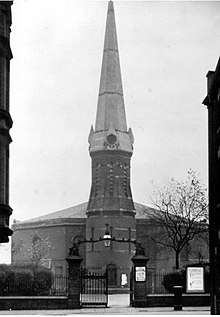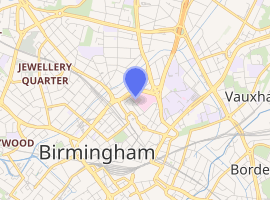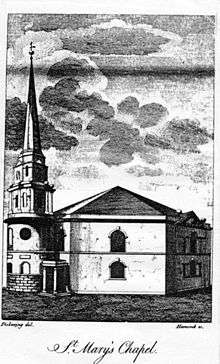St Mary's Church, Whittall Street, Birmingham
St Mary’s was a Church of England parish church in Whittall Street, Birmingham, England.
| St Mary’s Church | |
|---|---|
 St Mary's in 1880, with the remodelled tower | |

| |
| 52°29′6.2″N 1°53′46.4″W | |
| Location | Whittall Street, Birmingham |
| Country | England |
| Denomination | Church of England |
| History | |
| Dedication | St Mary the Virgin |
| Consecrated | August 1774 |
| Architecture | |
| Architect(s) | Joseph Pickford |
| Style | Neo-classical |
| Completed | 1774 |
| Construction cost | £4,700 |
| Closed | 1925 |
| Demolished | 1920s |
| Specifications | |
| Capacity | 1,000 people |
| Number of spires | 1 |
History

St. Mary's Church, Whittall Street, was built in 1774, under an Act of 1772,[1][2] as a chapel of ease to St Martin in the Bull Ring. The building was designed by Joseph Pickford.[3] Two years after opening, part of a gallery collapsed during a service, but the incident did not result in any injuries.
In 1786 John Wesley attended a service and heard a sermon by the first incumbent Edward Burn.[4]
A parish was assigned to St. Mary's in 1841 out of St Martin in the Bull Ring.


In 1859, 15 women (of a total of 19), who had died in an explosion at Messrs Pursall and Philips Percussion Cap Manufactory, also in Whittall Street, were interred in a single vault in the church.
Structural problems were discovered in 1866 and the tower and spire were subsequently rebuilt in a Gothic style.
In 1925 the church was closed pending demolition for the expansion of Birmingham General Hospital. The parish was united with that of Bishop Ryder Church.[2] The proceeds of the sale went to build St Mary's Church, at Pype Hayes.
Its registers of baptisms (1774–1812) and burials (1779–1812) are at St. Martin's.[2] Its silver communion service is at St. Mary's, except for two flagons which are in the collection of Birmingham Assay Office.[2]
The thoroughfare at the north-west side of the site is still called St Mary's Row.
References
- The History of Birmingham. William Hutton and James Guest. Rights and Webb. 1836
- A History of the County of Warwick. 7, the City of Birmingham. London: Victoria County History. 1964. pp. 361–379.
- Joseph Pickford of Derby, Edward Saunders, Sutton Publishing Ltd. 1993. p. 118
- W.B. Stephens (Editor) (1964). "Religious History: Churches built before 1800". A History of the County of Warwick: Volume 7: The City of Birmingham. Institute of Historical Research. Retrieved 16 December 2013.CS1 maint: extra text: authors list (link)